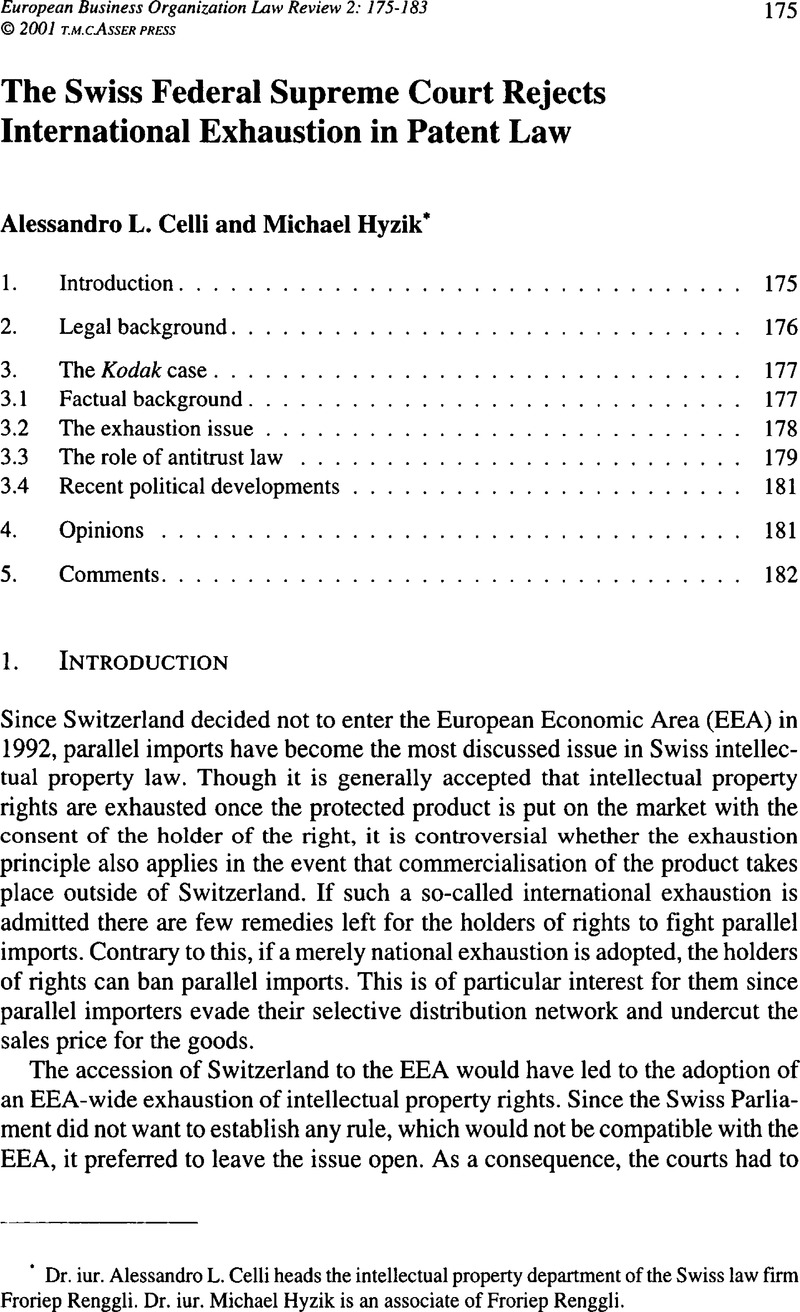No CrossRef data available.
Article contents
The Swiss Federal Supreme Court Rejects International Exhaustion in Patent Law
Published online by Cambridge University Press: 17 February 2009
Abstract

- Type
- Case Notes
- Information
- Copyright
- Copyright © T.M.C. Asser Press and the Authors 2001
References
1 Bundesgericht, , Entscheidungen des Schweizerischen Bundesgerichts, 122 III 469.Google Scholar
2 Bundesgericht, , Entscheidungen des Schweizerischen Bundesgerichts, 124 III 321.Google Scholar
3 Swiss jurisdiction and doctrine are aware that there is an international debate on the question whether Art. 6 TRIPS excludes the exhaustion issue from the scope of the agreement in general or if it applies only to dispute settlement proceedings; cf. Bollinger, , “Die Regelung der Parallelimporte im Recht der WTO”, Sic! – Zeitschrift für Immaterialgüter-, Informations- und Wettbewerbsrecht (1998) 546.Google Scholar
4 Zäch, , “Recht auf Parallelimporte und Immaterialgüterrecht”, Schweizerische Juristenzeitung (1995) 303, at pp. 305 et seq.Google Scholar
5 Knaak in a case note on Chanel in Gewerblicher Rechtsschutz und Urheberrecht. Internationaler Teil (1998) 520, at pp. 527.Google Scholar
6 Handelsgericht, , 97 Zürcher Rechtsprechung (1998) 289.Google Scholar
7 Ibid., at pp. 300 et seq.
8 Bundesgericht, , Entscheidungen des Schweizerischen Bundesgerichts, BGE 126 III 129.Google Scholar
9 Ibid., at para. 2.
10 Ibid., at paras. 2 and 3.
11 Ibid., at para. 5 (a).
12 Ibid., at para. 6.
13 Ibid., at para. 7.
14 Ibid., at para. 8.
15 Rauber, , “Parallelimporte zwischen Immaterialgüter- und Wettbewerbsrecht: eine Übersicht”, in: Rauber, (ed.), Parallelimport im Schnittstellenbereich zwischen lmmaterialgüter-und Wettbewerbsrecht (Zürich: Schulthess 2000) 1.Google Scholar
16 “Botschaft zu einem Bundesgesetz über Kartelle und andere Wettbewerbsbeschränkungen”, Bundesblatt, 1995 I 541.Google Scholar
17 Bundesgericht, supra n. 8, at para. 9 (a) and (b).
18 Rauber, supra n. 15, at p. 25.
19 Ibid., at p. 24.
20 Bundesgericht, supra n. 8, at para. 9 (c).
21 Ibid., at para. 9 (c).
22 Rauber, supra n. 15, at p. 24.
23 Ibid., at p. 26.
24 See the report on the debate in Neue Züricher Zeitung, 28 September 2000, 13.
25 This was stated by the Government when approving a report on the parallel import issue, which was ordered by a parliamentary commission after the Kodak decision, see <www.admin.ch/cp/d/393501c2.0fwsrvg.bfi.admin.ch.html>.
26 Tages Anzeiger, 1 March 2000, 31.
27 Zäch, , “Parallelimporte patentrechtlich geschützter Güter nach Massgabe des Kartellgesetzes”, Sic! – Zeitschrift für Immaterialgüter-, Informations- und Wettbewerbsrecht (2000) 275 at pp. 279 et seq.Google Scholar
28 Ibid., at pp. 282 et seq.; cf. also Hilty, , “Verbot von Parallelimporten – Heimatschutz oder Schildbürgerstreich?”, Sic! – Zeitschrift für Immaterialgüter-, Informations- und Wettbewerbsrecht (2000) 231 at pp. 239 et seq.Google Scholar
29 Ducrey, , “Kodak, selektiver Vertrieb und Graumarkt aus Sicht der schweizerischen Kartellrechts”, in: Rauber, (ed.), supra n. 15, at p. 125.Google Scholar
30 Rauber, supra n. 15, at p. 22.


